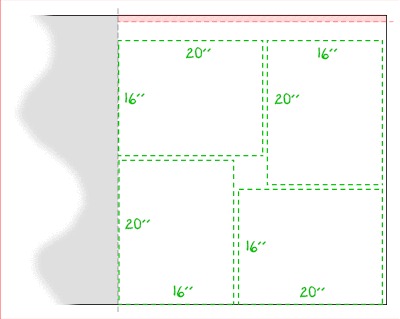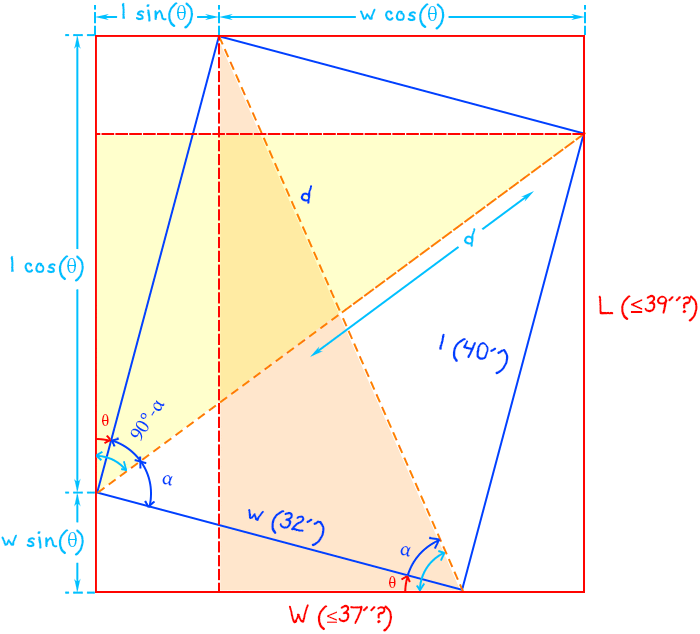I posted our first Simple Mat(h) Problem on April 27, 2017, and Jim Farrington submitted a solution a couple of weeks later. Here are a few more comments on the problem that I published (but in the wrong place).
Although the mat cutter has no kerf, the blade does swing down at the start of the cut and could cut into the side of your finished piece around that square in the middle. For backing boards, this is not a problem, and because at least 1/8” will be hidden by the moulding, it is probably not a problem when cutting mats either. There is enough extra space that if you wanted to play it safe, you could put a 1/2” between the four pieces as shown below.

Could There Be More Than Four Pieces?
To be blunt, NO. There just aren’t enough scraps to possibly make another 16″ by 20″ piece. Five such pieces would have an area of 5 x 16″ x 20″ = 1,600 square inches. We started with a 39″ x 37″ piece with 1,443 square inches. It just can’t be done.
Is There Another Way To Get The Correct Answer?
We’ve all managed to get a broom into a shorter closet by sliding it in at an angle. One question I had was, “Would it be possible to squeeze the originally planned 40″ by 32″ rectangle needed for the four pieces into the 39″ high space by rotating slightly?” The short answer is NO. Because this is so much wider than a broom, as you rotate, the required height actually gets larger at first and doesn’t drop back below 39″ until you’ve rotated over 79°. But by then, the necessary width would be over 45″ (well over the 37″ available). To see the math, see the note below (Warning: this “solution” requires knowledge of trigonometry). Of course, this doesn’t guarantee that there is no other way to solve this problem. If you find a slicker solution, let me know.
I made a drawing to help with the math.

The target 40″ by 32″ rectangular piece of foam board is shown by the dark blue rectangle. The red rectangle is the smallest “box” that can be placed around it. The length L of the outer box can be described as \( L = l \cos \theta + w \sin \theta. \)
This reminds me of a trigonometric identity for the sine or cosine of the sum or difference of two angles:
\( \sin (x \pm y) = \sin x \cos y \pm \cos x \sin y, \) and
\( \cos (x \pm y) = \cos x \cos y \mp \sin x \sin y. \)
Let d be the length of the diagonal of the inside rectangle. It can be found as \( d = \sqrt{l^2 + w^2}. \) Furthermore, \( \frac{l}{d} = \sin \alpha \) and \( \frac{w}{d} = \cos \alpha, \) where α is the angle that the diagonal makes with the base of the rectangle.
If we divide both sides of our first equation for L by d, we get:
\( \begin{array}{r c l} \frac{L}{d} & = & \frac{l}{d} \cos \theta + \frac{w}{d} \sin \theta \\ & = & \sin \alpha \cos \theta + \cos \alpha \sin \theta \\ & = & \sin (\alpha + \theta) \\ L & = & d \sin (\alpha + \theta) \end{array} \)
By the same token, the width W of the outer box can be described as
\( W = l \sin \theta + w \cos \theta. \)
Following a similar path as above, we can show that
\( W = d \cos (\alpha – \theta). \)
Now you can plug 39″ in for L, 51.225″ (which is square root of 402 + 322) for d, and 51.34° for α (by taking the arcsine (which may be shown as sin-1 on your calculator) of 40″/51.225″) into the last equation for L, and use your calculator to find that α + θ = 49.583°. Unfortunately, that’s less than α and doesn’t meet our requirements. But around a circle, there are two angles with the same sine. Your calculator will find the one that is less than 90° (we’ll call it 90° – φ). The other would be 90° + φ, which makes θ = 79.192°. Plugging that, along with d and θ, into the last equation for W gives the result I mentioned above.
A Shortcut?
That last equation for L could also have been found more directly by noticing the orange right triangle formed by the dashed orange line along the inside blue rectangle’s diagonal and through the lower right corner of the inside rectangle (as the hypotenuse), and the vertical dashed red line of length l (as the side opposite the angle), and the segment of the bottom edge of the outer rectangle that’s between those two other sides (as the adjacent side). The light blue arrows around that lower right corner show the angle of this right triangle is α + θ. Then by noticing the yellow right triangle formed by the other orange dashed diagonal line as hypotenuse and the other red dashed line of length w as the opposite side again we could have found that \( W = d \sin(\theta + (90 – \alpha)). \)
Then, since
\( \begin{array}{rcl} \sin x & = & \cos(90 – x), \\ W & = & d \cos(90 – (\theta + (90 – \alpha))) \\ & = & d \cos(\alpha – \theta). \end{array} \)
Now, aren’t you glad you asked?
Leave a Reply